Alsace is a beautiful destination for wine lovers, with rolling hills, fields, and farms overlooked by crumbling, romantic castles. One of the oldest wine-producing regions in France, the Alsace region is blessed with some magnificent vineyards. Here is everything you need to know about wine travel in Alsace so you can enjoy your trip to this historic wine region.
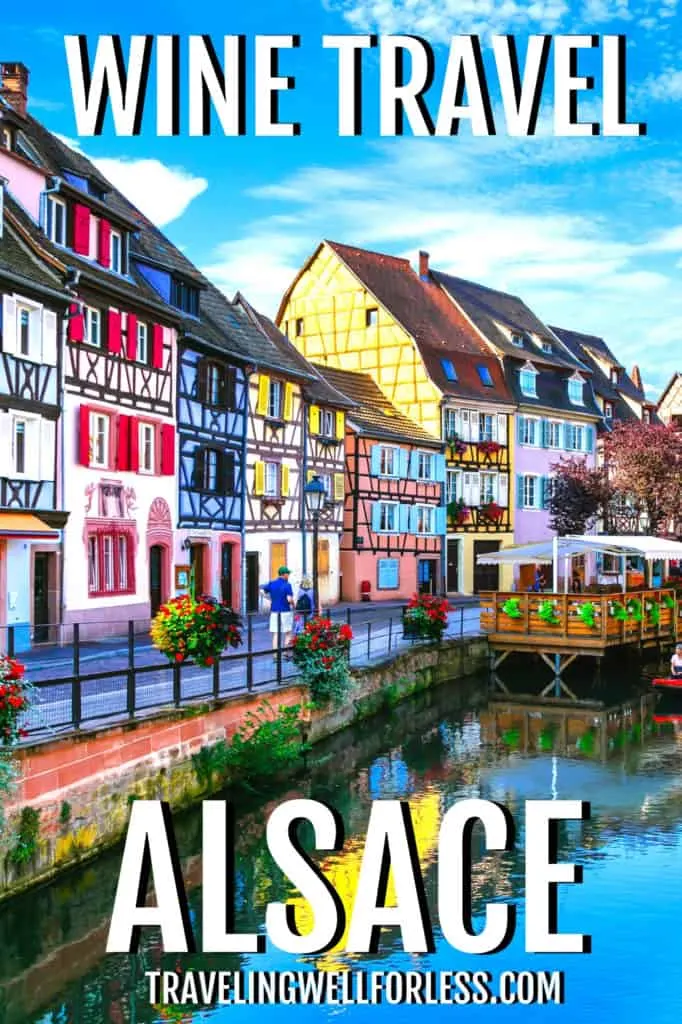
The Alsace Wine Route
Beginning in the North near the village of Marlenheim, the Alsace wine route continues south to Thann, just north of Mulhouse. The route passes through more than 100 wine-producing villages, most of which haven’t changed in hundreds of years.
You will find pretty houses with painted shutters, window boxes exploding with color, quaint clocktowers, pavement cafes, and cobbled squares. Each village also has a winstub, or wine tavern, a cozy eatery serving traditional food and local wine.
How to Get to Alsace
You can reach Alsace in several different ways, including by car, train, and plane. Driving to Strasbourg takes around five hours from Paris or Lyon. Trains connect Strasbourg to Paris (1 hour 44 minutes) and Lyon to Mulhouse (2 hours 50 minutes). If you are flying, the nearest airports are Strasbourg, Euroairport, and Basel in Switzerland.
When to Visit Alsace
Spring (March-May): Spring is a lovely time to visit Alsace as the countryside is in full bloom. You will avoid the crowds and the high prices of the summer season.
Summer (June-August): Summer is the peak holiday season in Alsace. The villages and vineyards are busy and crowded. Hotels and restaurants are also more expensive than at other times of the year.
Autumn (September-November): In Autumn, the region looks beautiful as the leaves begin to turn. The weather can still be quite warm, and many villages hold their own grape harvest festivals with concerts and processions.
Winter (December-February): Winter may not be the best time to explore the vineyards, but the towns and villages are festive and pretty, and many of them have enchanting Christmas markets. You can still visit wine cellars, taste local wines, and shop for them of course!
Alsace Travel Tips
Alsace attracts a lot of tourists, so seek out off-the-beaten-track villages if you want to avoid the crowds.
The wine-producing villages can get crowded, especially in the summer. Get up early in the morning to explore when the streets are deserted.
As one of the top regions in France for gastronomy, Alsace restaurants also get busy. Research where you plan to go for dinner and book in advance if necessary
How to Explore the Alsace Wine Route
There are many ways to explore the Alsace wine route, whether you are based in one location or traveling from village to village.
Traveling by car gives you the most flexibility while you enjoy Alsace wine tasting. The entire route is around 105 miles meaning you can see it all in a few days if you drive at a leisurely pace. But parking can be difficult, especially in the high season.
Trains connect the larger cities and towns like Strasbourg and Colmar but not the smaller villages. Public buses are available but sporadic. You can also visit vineyards during a Rhine River cruise.
Cycling and walking are both lovely ways to see Alsace and give you the freedom to travel at your own pace, taking in the countryside along the way. Walkers can hike along the many designated wine paths and trails, staying overnight along the way. Or, cycle along the many decent cycle paths that take you up and down gentle hills and among the vines.
The Alsace Vineyards
Sheltered by the Vosges mountains, Alsace vineyards receive plenty of sun and little rain, which allows the grapes to ripen slowly. Different soils are often found within one estate, meaning one producer can grow many different grapes. Many Alsace wine producers have embraced biodynamic growing, inspired by Austrian philosopher Rudolf Steiner.
Alsace Wines
The best-known wines from Alsace are dazzling Rieslings and Gewürztraminers. As well as these, white wines include Muscat, Pinot Gris, Sylvaner and Pinot Blanc. The only red wine is made with Pinot Noir.
Alsace also produces some of the best crémant (sparkling) wines in France, as well as late harvest wines known as Vendange Tardives (VT) and Sélection de Grains Nobles (SGN), which have higher levels of sugar.
While all Alsace wines are made with 100 percent of one grape variety, you can also find Alsace Blanc, a blend of Alsace AOC wines.
The Appellations
Wines produced in Alsace are produced in three designated regions aka Appellations d’Origine Controlees (AOCs).
Alsace Grand Crus
Grand Crus wines are produced on the best – and usually the oldest – land in the region. There are 51 Grand Crus sites in Alsace; the majority are in the south (Haut Rhin), although there are some in the north (Bas Rhin) too.
Alsace AOC
Standard wines produced all over Alsace belong to this appellation, and include red, white, rose, dessert wines, vendages tardives and grains nobles
Crémant Alsace
Alsace produces some of France’s best crémant (sparkling) wines. These wines are produced by the same method as Champagne. Cremant wines are mostly produced in Barr, Bennwihr, Eguisheim. Ingersheim, Riquewihr, Wintzenheim and Andolsheim
Food
Food is extremely important in Alsace and has a German twist. Try local specialties such as choucroute (sauerkraut) spaetzle (German pasta) and of course, gingerbread. The region is known for fine dining and has many Michelin-starred restaurants.
Things To Do
About halfway along the wine route, Colmar is a town full of pretty pastel-colored houses and canal-side cafes. There are many photogenic castles perched on hilltops offering stunning views of the countryside. Château du Haut-Kœnigsbourg is the most famous, but there are more than 500 in total.
Book Pass Alsace
Best of Alsace: Admission to 50 attractions including castles, museums, and wildlife parks
Alsace has plenty to offer outdoor lovers, from hiking in the Vosges mountains to exploring the Rhine, or the 1,677 miles of bike trails.
Where to Stay in Alsace
There is an excellent selection of hotels, bed and breakfasts, and campsites in Alsace. Many of the nicest places to stay are run by the vineyards and are good value. Here are a few options:
- Bleu Minuit – Luxury ecolodges with floor-to-ceiling windows located in Vosges du Nord Natural Park. Gourmet restaurant on site.
- Villa Rene Lalique – Former villa of French glass and jewelry designer Rene Lalique now a luxury 5-star boutique hotel with 2 star Michelin restaurant.
- Les Jardins de Madeleine – Intimate contemporary B&B with wood-beamed rooms and lovely grounds set on 4 hectares.
- Hostellerie La Cheneaudiere & Spa – Luxury 5 Star boutique spa hotel with an onsite restaurant. Rooms have TV, airconditioning, safe, Nespresso machine, free Wi-Fi.
Wine Producing Areas in Alsace
Wissembourg
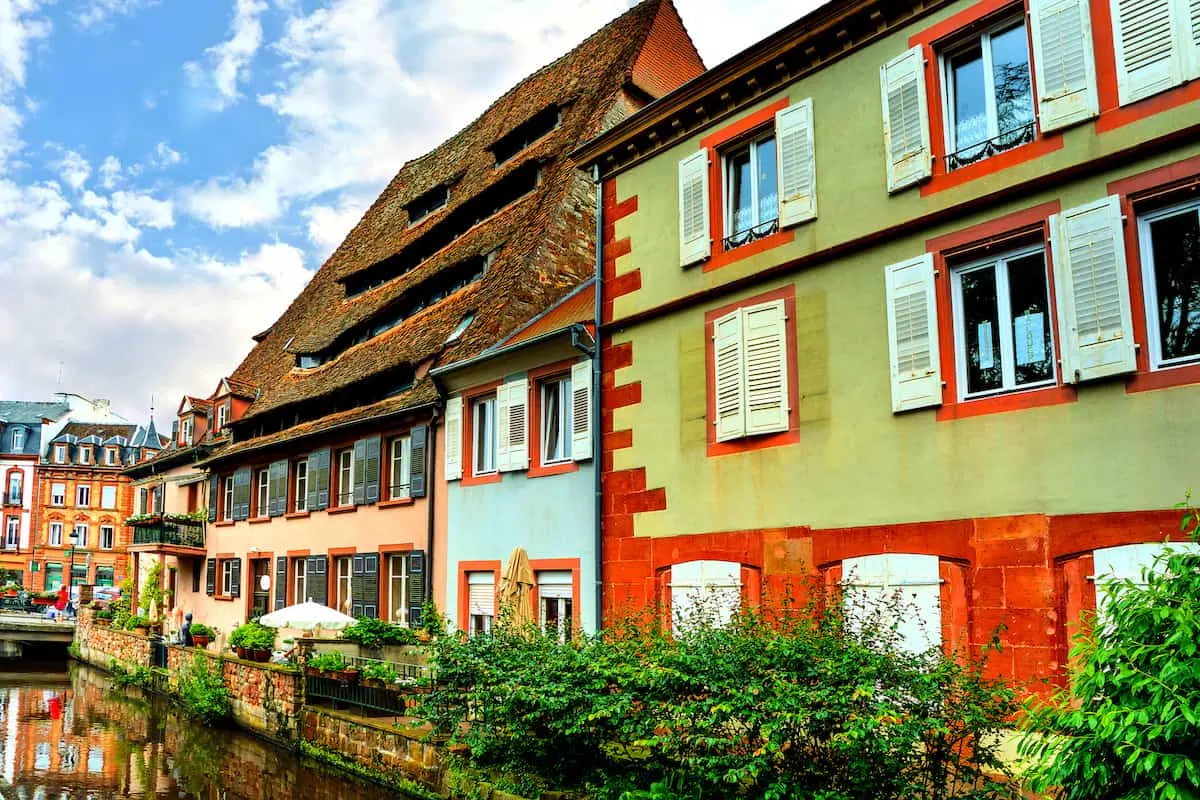
The area around Wissembourg (Pays de Wissembourg) is a pretty section of the wine route, and home to some of the oldest vineyards – first planted in the 8th century. Outdoor lovers can hike and cycle in the Northern Vosges Regional Natural Park, which is a UNESCO biosphere. The village of Hunspach is considered one of ‘the most beautiful villages in France’.’
Wissembourg Vineyards
- Cave Vinicole de Cleebourg, Route du Vin, 67160 Cleebourg, +33 3 88 94 50 33
- Maison Jülg, 116 Rue des Églises, 67160 Seebach, +33 3 88 94 79 98
Where to Stay in Wissembourg
- Le Cheval Blanc – Historic 4 star hotel with a 2 Michelin star restaurant and spa; rooms have air conditioning, TV, refrigerator, and free Wi-Fi. Free parking.
- La Coeur de Lise – Romantic B&B with a pool and an onsite restaurant; rooms have air conditioning and free Wi-Fi
- Au Tilleul – Small romantic inn built in 1888 with an onsite restaurant serving regional seasonal cuisine; rooms have air conditioning.
Where to Eat in Wissembourg
Pro-tip: Try to make time to have a meal at the 2 star Michelin Restaurant Villa Rene Lalique between Wissembourg and Strasbourg.
Strasbourg
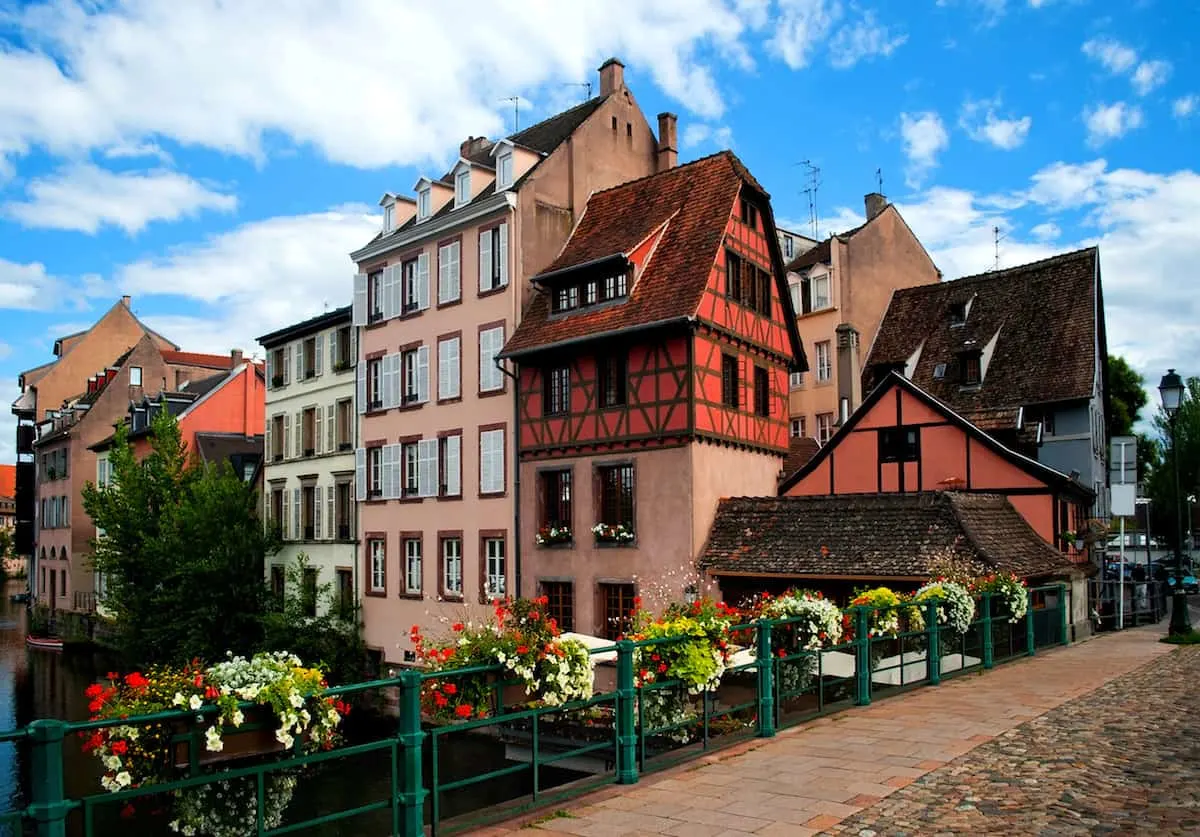
At Strasbourg (Vignoble de Strasbourg), the wine route passes through the agricultural heartland of Alsace. This area is known for hops growing and breweries as well as vineyards. It is also the place where the famous rustic dish Flammkuchen is made.
There are excellent hiking and biking trails. The convent of Mont Sainte-Odile is worth visiting for panoramic views of the countryside. Obernai is a charming village with a beautiful church.
Strasbourg Vineyards
- Bernard Becht, 84 Grand Rue, 67120 Dorlisheim, +33 3 88 38 20 37
- Metz, Arthur 102 Rue du Général de Gaulle, 67520 Marlenheim, +33 3 88 59 28 69
- Mochel, Federic 56 Rue Principale, 67310 Traenheim, +33 3 88 50 38 67
- Mochel-Lorentz Viticulteurs, 19 Rue Principale, 67310 Traenheim, +33 3 88 50 38 17
- Domaine Pfister, 53 Rue Principale, 67310 Dahlenheim, +33 3 88 50 66 32
Where to Stay in Strasbourg
- 5 Terres Hotel and Spa – Luxury boutique family-friendly hotel with views of Alsatian vineyards, pool, a spa, and an onsite restaurant. Rooms have air conditioning and free Wi-Fi. Free parking.
- Le Parc Hotel Obernai & Spa – 4-star hotel with spa, pool, and onsite restaurant. Rooms have air conditioning, TV, and free Wi-Fi. Free parking.
- Garrigae Villa La Florangerie – Boutique hotel with stylish rooms, satellite TV, safe, Nespresso machine, and air conditioning. Swimming pool. Views of Salon de Provence.
- La Rose d’Alsace – Intimate guesthouse dating back to the 18th Century. Rooms have their own bathrooms and include traditional Alsatian breakfast. A 25-minute drive from Strasbourg.
Where to Eat in Strasbourg
Couer D’Alsace (Heart of Alsace)
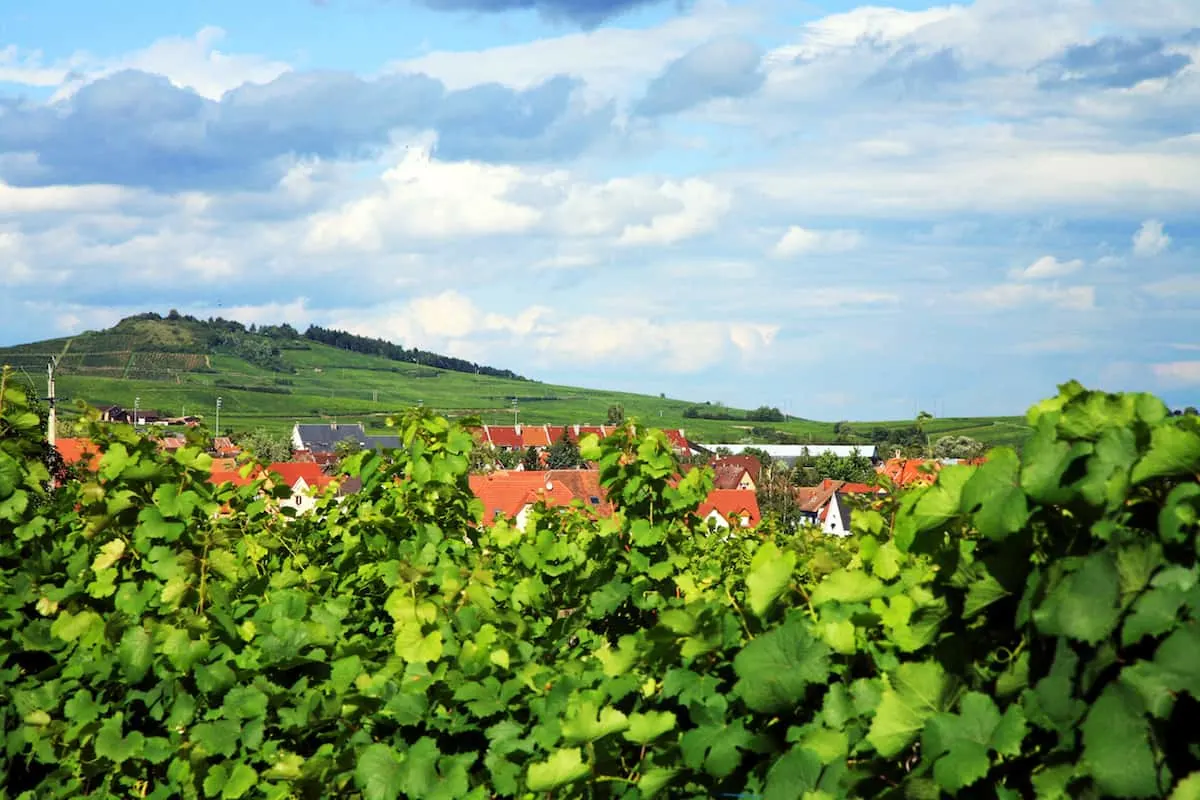
North of Colmar in Couer D’Alsace is where the wine route starts to get busy. There is plenty to see in this area, including plenty of castles and old villages.
If you have a sweet tooth you might want to stop in Gertwiller, where Alsatian gingerbread (pain d’epices) is made.
Villages worth visiting include Andlau, founded in the 9th century and Scherwiller, known for its Riesling wines. Chateau de L’Ortenbourg is a ruined hilltop castle you can hike to.
Coeur d’Alsace of Alsace Vineyards
- Beck, Francis 79 Rue Sainte-Marguerite, 67680 Epfig, +33 3 88 85 54 84
- Domaine Marcel Deiss, 15 Route du Vin, 68750 Bergheim, +33 3 89 73 63 37
- Domaine André Kientzler, 50 Route de Bergheim, 68150 Ribeauvillé, +33 3 89 73 67 10
- Marc Kreydenwiess, 12 Rue Deharbe, 67140 Andlau, +33 3 88 08 95 83
- Domaine Ostertag, 87 Rue du Finkwiller, 67680 Epfig, +33 3 88 85 51 34
Where to Stay in Coeur d’Alsace
- Les Prés d’Ondine – Cozy 12-room riverside hotel. Sauna and jacuzzi on property. Rooms have TVs and free Wi-Fi.
- Zinck Hotel – Quirkly 18 room non-smoking hotel in former 17th-century corn mill. Six minute walk to central Andlau. Rooms have TVs.
- Hotel Château De Grunstein – Boutique all-suite B&B 16th century chateau on Muehlbach River. Room has TV and private bathrooms. Two minute drive to Wine Road.
Where to Eat in Coeur d’Alsace
Colmar (Terre et Vin au Pays de Colmar)
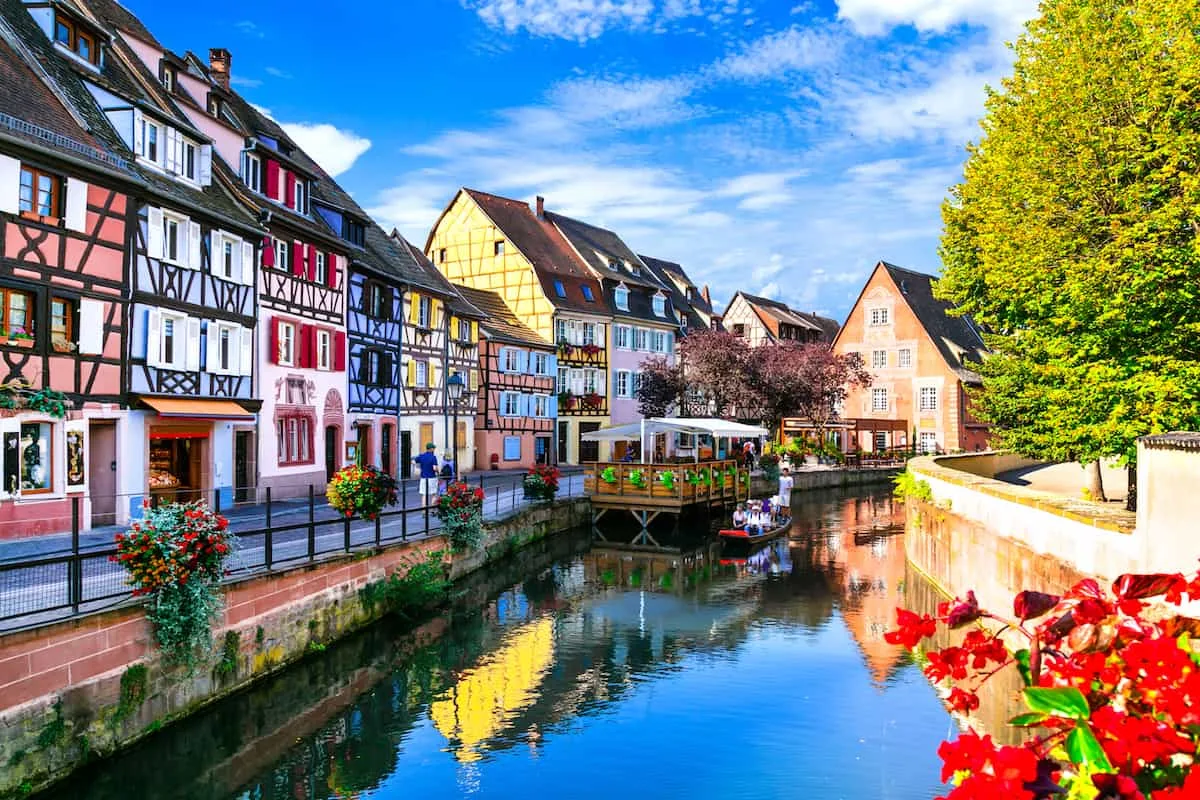
Terre et Vin au Pays de Colmar, the area west of Colmar is the busiest section of the wine route and is home to some of the finest Grand Cru sites of the region, as well as many of the most beautiful villages, including Ribeauvillé, Riquewihr, and Eguisheim. Bergheim, which is a fortified village with well-preserved walls, is also worth visiting.
Castle fans will not be disappointed; as well as the famous Chateau Haut Koenigsbourg, there is also the 13th-century Chateau Schlossberg. And then there is Colmar itself – the capital of the Alsace wine region, which has some excellent restaurants.
Terre et Vin au Pays de Colmar Vineyards
- Jean Baptiste Adam, 5 Rue de l’Aigle, 68770 Ammerschwihr, +33 3 89 78 23 21
- Léon Baur, 22 Rue du Rempart N, 68420 Eguisheim, +33 3 89 41 79 13
- Domaine Emile Beyer, 7 Place du Château Saint-Léon, 68420 Eguisheim, +33 3 89 41 40 45
- Domaine Jean-Marc Bernhard, 21 Grand Rue, 68230 Katzenthal, +33 3 89 27 05 34
- Domaine Bott-Geyl, Rue du Petit Château, 68980 Beblenheim, +33 3 89 47 90 04
- Barmès-Buecher, 30 Rue Sainte-Gertrude, 68920 Wettolsheim, +33 3 89 80 62 92
- Domaine Dopff au Moulin, 2 Avenue Jacques Preiss, 68340 Riquewihr, +33 3 89 49 09 69
- Domaine Josmeyer, 76 Rue Clemenceau, 68920 Wintzenheim, +33 3 89 27 91 90
- Maison Gustave Lorentz, 91 Rue des Vignerons, 68750 Bergheim, +33 3 89 73 88 07
- Maison Trimbach, 15 Route de Bergheim, 68150 Ribeauvillé, +33 3 89 73 60 30
- Domaine Weinbach, 25 Route du Vin, 68240 Kaysersberg, +33 3 89 47 13 21
- Wolfberger, 6 Grand-Rue, 68420 Eguisheim, +33 3 89 22 20 46
- Domaine Zind-Humbrecht, 2 Route de Colmar, 68230 Turckheim, +33 3 89 27 02 05
Where to Stay in Terre et Vin au Pays de Colmar
- Aux Armes de France – Comfortable non-smoking pet-friendly small hotel with onsite former Michelin starred restaurant. Rooms have TV and free Wi-Fi.
- Hotel KLE – Former wine-growers house turned elegant boutique hotel in Kaysersberg village in the heart of the Alsace vineyards. Rooms are non-smoking with memory foam beds, air-conditioning, Nespresso machine, TV and free Wi-Fi. Pet-friendly.
- Hôtel A l’Agneau – Cozy hotel above restaurant. Rooms have TVs.
- Hôtel Haut-Koenigsbourg – Charming small hotel in an 18th Century building with an onsite restaurant. Rooms have TVs. Free parking. 10 minutes from Ribeauville.
Where to Eat in Terre et Vin au Pays de Colmar
Southern Alsace
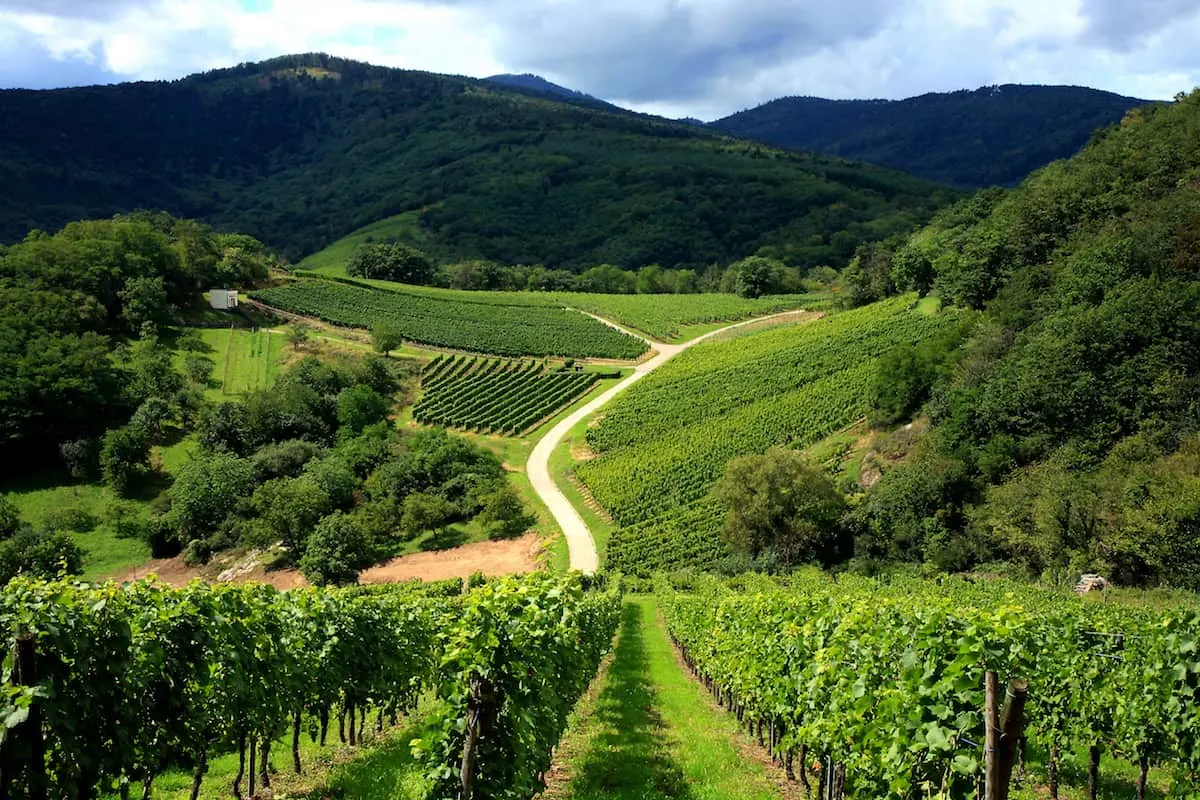
Southern Alsace is known for its Rangen Gran Cru site which produces some of the best wines in the whole region. There is plenty to see and do along this section of the wine route, including the medieval village of Guebwiller, and for walkers, the Grand Ballon, which is the highest point in the Vosges mountains. This area makes a great base for outdoor lovers wishing to explore the Regional Natural Park Ballons des Vosges.
Southern Alsace Vineyards
- Pierre Frick, 5 Rue de Baer, 68250 Pfaffenheim, +33 3 89 49 62 99
- Domaine Valentin Zusslin, 57 Grand Rue, 68500 Orschwihr, +33 3 89 76 82 84
- Lucien Albrecht, 28 Rue du Printemps, 68500 Orschwihr
- Schmitt François Cave, 19 Rue de Soultzmatt, 68500 Orschwihr, +33 3 89 76 08 45
- Chateau d’Orschwihr, 1 Rue du Ctre, 68500 Orschwihr, +33 3 89 74 25 00
- Domaines Schlumberger, 3 Rue des Cours Populaires, 68500 Guebwille, +33 3 89 74 27 00
Where to Stay in Southern Alsace
- Chateau d’Isenbourg & Spa – Luxury, 5 Star, family-friendly nonsmoking hotel with spa, pool, tennis court, and onsite restaurant on a vineyard in the heart of the Alsace wine route. Views of Alsace, the Black Forest, the Vosges, and Colmar. Rooms have satellite TV, safes, free bottled water, and free Wi-Fi. Free parking.
- Hotel du Bollenberg – Nonsmoking hotel with spa and pool on a vineyard. Soundproofed rooms include satellite TV and free bottled water. Views of Alsace, the Black Forest, and the Vosges Mountains. Free parking. Minutes from Eguisheim and Kaysersberg.
Where to Eat in Southern Alsace
Conclusion
If the Alsace Wine Route is on your bucket list, you’ll love this guide to wine travel in Alsace for everything you need to know about this famous wine route.
One hundred and five miles of picturesque villages, castles, more than 100 vineyards, and Michelin-starred restaurants make up the Alsace Wine Route. The best time to visit to avoid crowds and save on prices is the Spring.
Have you been wine traveling in Alsace? Which villages were your favorites on the Alsace Wine Route? If you haven’t gone on an Alsace wine tour, which villages would you visit?
Comment, tweet, or share this post.
Get the best credit card bonuses.
Follow us on Twitter | Facebook | Pinterest | Instagram | YouTube
Got a question? Or want help, suggestions, travel tips, learn how to travel for free, find out about travel deals, and maximize your miles and points? Use the subscription box below to sign-up and get post updates by email.
Traveling Well For Less has partnered with Your Best Credit Cards for our coverage of credit card products. Traveling Well For Less and YBCC may receive a commission from card issuers.



Christine Filipovich
Saturday 7th of August 2021
Thank you for the detailed post! Heading there later this month.